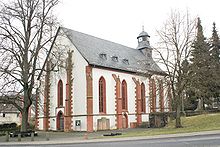Monastery Church (Hirzenhain)
The former Protestant monastery church is a Gothic hall church in Hirzenhain in the Wetterau district in Hesse . It belongs to the Protestant parish Hirzenhain in the Evangelical Church in Hesse and Nassau .
history
The monastery was established as an Augustinian canons monastery by Eberhard II von Eppstein-Königstein between 1431 and 1437 at a Marienkapelle, to which pilgrimages had been taking place since the second half of the 14th century . After the death of the last Eppsteiner , Eberhard IV von Eppstein-Königstein , the monastery passed to the von Stolberg family. The wealthy monastery had a mine and an ironworks since the middle of the 15th century, which were continued as Stolberg's ironworks after the middle of the 16th century and were bought by the Buderus family in the 19th century .
The monastery was dissolved in 1568/1569 and served as a Latin school from 1569 to 1595, then as the Stolbergsches Hofgut.
architecture
The monastery church, originally consecrated to Saints Maria , Anna and Antonius , a late Gothic hall church without a tower with a choir made up of two bays and a five-eighth end , has served as a Protestant parish church since 1689 . The choir includes the former pilgrimage chapel, which was started towards the end of the 14th century and not completed until 1431, similar to the choir of the Ortenberg church . The nave was started after 1437 and by the brother-in-law of the monastery founder Frank IX. von Cronberg and his wife Katharina von Ysenburg , whose alliance coat of arms can be found in the keystone , completed in the middle of the 15th century and consecrated in 1448. Renovations were carried out in 1760, 1882 to 1897, 1955 and 1969 to 1978; the northern annex was renovated in 1970.
The exterior is accentuated by a roof turret with a hood over the end of the choir. Stepped buttresses characterize the exterior, the tracery in the nave and in the southern choir window shows snows , the other windows in the choir are quadrilateral . The hall church of 3 × 3 bays with four octagonal free pillars shows a well-proportioned spatial image, the side aisles are each half as wide as the central nave. The parts of the room are closed with ribbed vaults and keystones with relief . The services are based on the church architecture in Frankfurt am Main , which was influenced by Madern Gerthener , possibly mediated by his student Stephan von Irlebach, who also worked in Kronberg im Taunus . In the choir, the rib vaults are intercepted by service bundles . Remnants of late Gothic wall paintings show medallions with Christ and the apostles, and the handkerchief of Veronica over the east window . On the inner wall of the rood screen , Christ as the judge of the world and the crucifixion are depicted.
The dainty rood screen from around 1440–1448 is architecturally in the footsteps of Madern Gerthener; the sculptural works are possibly early works by the Cologne cathedral builder Konrad Kuyn . The rood screen consists of five arcades with tracery parapets, ribbed vaults with keystones, ten round reliefs with scenes from the life of the Virgin are arranged in the arches. A reconstruction of the original arrangement of the figures of Saints Peter , Paul and Augustine with a badly damaged Mother of God is planned.
Furnishing
The late Gothic basket of a pulpit with flat carvings from around 1500 was transferred here from the church of Groß-Felda, which was demolished in 1971 .
Some valuable late Gothic sculptures are also noteworthy, especially the life-size Mary as Queen of Heaven made of unmounted limestone , once with a reliquary capsule on her chest, which was created around 1430/1440 and is attributed to Konrad Kuyn; an associated console is placed in the choir. Of similar importance are three life-size late Gothic carved figures, which may come from the high altar retable that was broken off in the 19th century , including a Madonna from around 1460, made of oak and supplemented with limewood. The figures of John the Baptist and Antonius the Hermit are stylistically younger, but apparently related to the Mother of God in their composition , both of which were made in linden wood around 1510/1520 and were last restored in 1975. At the triumphal arch a valuable crucifix from linden wood is attached from the beginning of the 15th century; the socket was removed. Two less than life-sized wooden figures show the Mother of God as Queen of Heaven from the last third of the 15th century and a rustically crafted Anna herself from the beginning of the 16th century. A figure tombstone in the forms of the early Renaissance for Eberhard IV. Von Eppstein-Königstein († 1535) has been preserved mutilated.
On the historical west gallery in the nave is the prospectus of an organ that was created by Johann Michael Stumm in 1771 and comes from the church in Alzey ; the Rückpositiv is a style imitation from 1976. The organ is a work by the Oberlinger brothers from 1976 with 33 stops on three manuals and pedal . The organ in the choir with ten registers was created by Georg Link in 1841.
literature
- Georg Dehio : Handbook of the German art monuments . Hessen II. The administrative district of Darmstadt . 2nd edition, Deutscher Kunstverlag, Munich, Berlin 2008, ISBN 978-3-422-03117-3 , pp. 454–456.
Web links
- Website of the Protestant parish Hirzenhain
- Information about the monastery church on the website of the community
Individual evidence
- ↑ Information about the organ on orgbase.nl. Retrieved September 18, 2019 .
Coordinates: 50 ° 23 ′ 31.6 ″ N , 9 ° 8 ′ 6.1 ″ E


